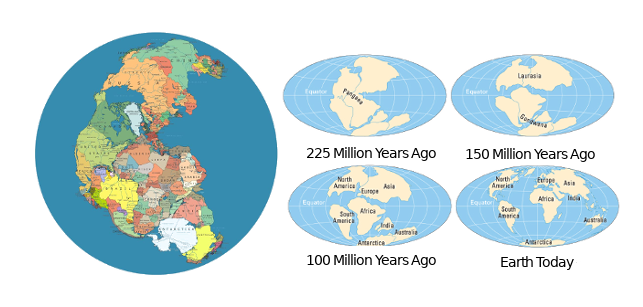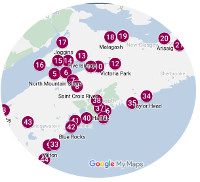- Why Mining Matters
- Jobs
- Safety
- Environment & Operations
- FAQ
- Links
- Fun Stuff

Nova Scotia has not always looked the way it does today. The province is comprised of at least three different continents that came together as a result of tectonic plate movement hundreds of millions of years ago.
The Earth’s surface is made up of huge plates of continental crust that are between five and 35 kilometres thick and are floating on the Earth’s mantle, the mostly-solid layer of rock that lies between Earth’s dense, super-heated core and its thin outer layer, the crust. The mantle is about 2,900 kilometers (1,802 miles) thick, and makes up about 84% of Earth’s total volume. Scientists have discovered that, encircling the globe, there are a dozen large plates as well as a number of smaller ones.
These plates move imperceptibly, at a rate of a few centimetres each year, and over the course of millions of years continents and oceans move and change shape. The plates pulling apart cause fractures or deep rifts in the Earth’s crust, both on land and under the sea, and plates colliding with each other form mountain ranges and new islands as the rock is forced upwards. We call this movement plate tectonics.
When all the continents collided about 290 million years ago, they formed the supercontinent Pangea, the most recent of a series of supercontinents that have been formed in earth’s 4.5 billion year history. At that time, the northern half of Nova Scotia was attached to western Europe and the southern half was connected to Africa.
About 200 million years ago Pangea began to pull apart once again, creating new land masses, such as Nova Scotia. It is often suggested that the continents as we know them today look like they fit together, like a jigsaw puzzle, because they were joined at one time.
Much of Nova Scotia’s geology – its underground physical structure – matches that of Europe and Africa as a result of our connection to those continents so long ago.
Tectonic plate movement has also caused huge changes in Nova Scotia’s climate. At different times over hundreds of millions of years Nova Scotia has been tropical, arid and covered in several kilometres of ice! For example, Nova Scotia was much closer to the equator during Pangea and it had very little rain (maybe just once or twice a year) and summers were about 20 degrees Celsius hotter than they are now.
Tectonic plate movement continues today and the next supercontinent is predicted to form within the next 250 million years. Nova Scotia – indeed, the whole world – will look very different in millions of years than it does now.

Supercontinent Pangea. The continents as we know them today fit together like a jigsaw puzzle.
200-300 million years ago, when the continents were joined in Pangea, there was only one ocean: Pangea was a huge island in a global body of water. As Pangea broke up, water went between continents, creating the oceans. The Atlantic formed as Africa and Europe split from South America.
ADDITIONAL INFO
- Further reading: http://www.virtualmuseum.ca
- A video about Nova scotia’s Geology is available at https://novascotia.ca




























































































